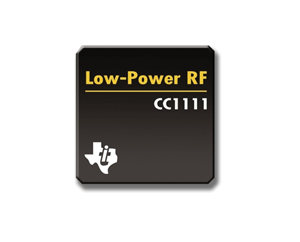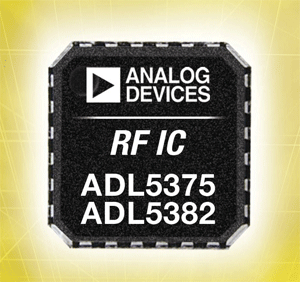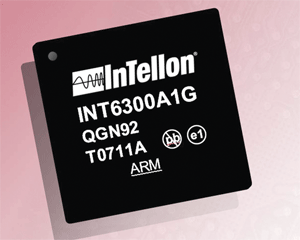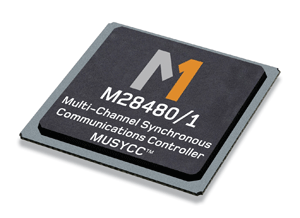One of the most interesting and fastest changing areas of electronics, communication and networking ICs are the backbone of many hot new products. In the past few months we have seen a number of very interesting new chips arrive on the scene. Here are a few we think you might want to know about.
Suited for wireless sensor networking, the CC1111 sub-1-GHz RF SoC with USB controller from Texas Instruments (Dallas, TX) is offered as the first of its kind, enabling a fast and easy bridge between PCs and RF.

The CC1111 sub-1-GHz RF SoC with USB controller from Texas Instruments
The CC1111 also has a CC1101 RF transceiver (with an enhanced 8051 MCU), and 8/16/32 Kbytes of in-system programmable flash memory for improved low-power performance.
Additional features include an embedded 128-bit AES security coprocessor, sleep current consumption of 0.3 µA, programmable data rate of up to 500 kbaud, a voltage range from 2.0 to 3.6 V, and four flexible power modes for reduced power consumption. The CC1111 is pin and register compatible with the CC1110 (sub-1-GHz SoC without USB), CC2511 (2.4-GHz SoC with USB) and CC2510 (2.4-GHz SoC without USB).
Supporting HDMI and Wireless HD transmission applications, the ADV216 video codec from Analog Devices (Wilmington, MA) features the company’s Wavescale compression technology, which is based on the JPEG2000 video compression standard. The chip also includes the company’s SURF (spatial ultraefficient recursive filtering) wavelet technology, which enables real-time compression and resolution scalability without the need for external memory.
Features include an application program interface that simplifies system design by allowing compressed data rates to be managed on a frame-by-frame basis, which frees HDTV manufacturers from having to design to worst-case transmission conditions. Housed in a BGA package, the codec also adapts to changing conditions, such as wireless data rate changes due to interference or other factors, without interrupting or dropping video frames.
Also from Analog devices comes the the ADL5375 and ADL5382 quadrature I-Q modulator and demodulator. The ADL5375 modulator operates from 400 MHz to 6 GHz and is said to have a 24-dBm output IP3, the industries highest linear output power at +10-dBm P1dB, and a low –161-dBm/Hz noise floor.

The ADL5375 and ADL5382 quadrature I-Q modulator and demodulator from Analog Devices
The ADL5382 demodulator chip operates from 700 MHz to 2.7 GHz with second- and third-order intercept point specifications of 60-dBm IP2 and 30-dBm IP3, and input compression of 13-dBm P1dB.
There is a continuing move toward integrated solutions that reduce component count and offer a small/low-profile footprint for the latest mobile and portable consumer devices. Fairchild Semiconductor (South Portland, ME) recently released the FPF218x and FPF219X series of IntelliMAX advanced load switches that feature smart power management functionality within a single switch.
The family uses a 1 x 1.5-mm wafer-level chip-scale package (WL-CSP), and are said to be the smallest switches of their class. They target 1.8 to 5.5-V operation and integrate a low RDS(on) current-limited p-channel MOSFET with protection and control features, including thermal shutdown, controlled turn-on, reverse-current blocking, and under-voltage lockout.
Housed in QFN surface-mount laminate packages, the XR1007-QD receiver and XU1005-QD transmitter from Mimix Broadband (Houston, TX) cover the 10 to 18-GHz frequency bands. The receiver has a 2.7-dB noise figure and a 20-dB image rejection, while the transmitter has a 11-dBm output P1dB, an 8-dB conversion gain, and a 15-dB image rejection across the band.
The WSR601 CMOS wireless USB chip from Wisair (Campbell, NY) integrates a UWB PHY (including RF), a MAC, and wireless USB subsystems. Targeting both host and device applications, the device is based on WiMedia and Certified Wireless USB standards and features SDIO and USB 2.0/1.1 interfaces along with wireless USB isochronous data transfer and association models. Typical power consumption is 400 mW at 100 Mbits/s and 0.5 mW in sleep mode.
The MC33696 from Freescale Semiconductor (Austin, TX) is a highly integrated transceiver designed for low-voltage applications in the 304-, 315-, 426-, 434-, 868-, and 915-MHz ISM bands, suiting wireless control applications. It includes a programmable PLL for multichannel applications, an RSSI circuit, a strobe oscillator that periodically wakes up the receiver while a data manager checks the content of incoming messages. A configuration switching feature allows automatic changing of the configuration between two programmable settings without the need of an MCU.
Tackling 200-Mbit/s home networking over powerlines, the INT6300 from Intellon (Ocala, FL) is a second-generation HomePlug AV IC provides a MAC/PHY transceiver and an analog front-end in a single multichip module.

The INT6300 second-generation HomePlug AV IC from Intellon
The chip has MII (Ethernet) and PCI host interfaces and provides a faster processor, reconfigured internal bus structure, and faster memory bus to speed data flow and reduce latency. It supports 1,024/256/64/16/8-QAM, QPSK, BPSK, and ROBO modulation schemes with 128-bit AES link encryption and requires no external flash memory for boot-from-host applications. It features dynamic channel adaptation, channel estimation, advanced turbo code forward error correction, and windowed OFDM with noise mitigation to improve data integrity in noisy conditions.
Another provider of powerline networking, Design of Systems on Silicon (DS2) (Paterna, Valencia Spain), has announced availability of it’s MONTGO powerline communications chip set for the consumer market. MONTGO provides a maximum data rate of 100 Mbit/s and targets data applications. Products designed for internet sharing, audio distribution or data networking applications can benefit from the low cost devices, which offers full interoperability with the companies UPA-DHS-compliant 200- and 400-Mbit/s products.
Samples will be available to customers during the first quarter, with production volumes scheduled for the second quarter. The chip set (the DSS8101 PHY/MAC chip and the DSS7800 AFE chip) is priced at $5.55 in volume.
The DeviceLinx XChip SoC networking system-on-chip coprocessor from Lantronix (Irvine, CA) enables manufacturers to embed serial-to-Ethernet connectivity and web services into high-volume, price-sensitive products so they can be remotely managed.
The chip enables a host microcontroller to function at maximum capacity without the burden of network-processing overhead and includes an x86 class processor, an Ethernet MAC and 10/100 PHY, and 256 Kbytes of zero wait-state SRAM, It has a high-performance UART, a built-in Web server, and 256-bit AES encryption, and comes in a 12 x 12-mm BGA184 package.
The MUSYCC M28480 and M28481 HDLC/SS7 multichannel synchronous communications controllers from Mindspeed Technologies (Newport Beach, CA) format and de-format 512 bidirectional HDLC/SS7 channels, and also provide for running Message Transfer Protocol (MTP) 1 and 2 in hardware.

The MUSYCC M28480 and M28481 HDLC/SS7 multichannel synchronous communications controllers from Mindspeed Technologies
The chip enables networking equipment to terminate both data and signaling system 7 (SS7) traffic using the high-level data link control (HDLC) protocol.
The 23-mm-square PBGA484-packaged processors include a software convergence layer between their drivers and Trillium signaling software, creating a seamless application development system. The chips have one PCIe single-lane endpoint or one PCI bus interface, and include eight serial interfaces supporting mixed data rates including T1/E1/T3/E3, HSSI, and 8.192 to 32.728-Mbit/s TDM modes.
Targeted at products with embedded Wi-Fi functionality, the CX53322 and CX53328 802.11n chips from Conexant Systems (Newport Beach, CA) deliver 11n data rates as high as 72 Mbits/s and are backward compatible with 11g data rates from 6 to 54 Mbits/s and 11b data rates from 1 to 11 Mbits/s.
The CX53322 has been recognized as a Wi-Fi certified 802.11n draft 2.0 product and is offered with a USB interface. The CX53328 is has a serial peripheral interface and secured digital interface. Both devices support popular operating systems including Linux, Windows CE, Windows XP, Windows Vista, and embedded real-time operating system drivers.
Said to be the industry’s first single-chip dual-port 10 Gigabit Ethernet converged-network interface controller (C-NIC), the NetXtreme II BCM57710 from Broadcom (Irvine, CA) has dual 10-Gbit/s MACs and dual XAUI/10GBASE-CX4/10GBASE-KX4 interfaces. The IC has a TCP/IP processing engine, iSCSI, remote direct memory access, and remote management. It offloads the processing of networking protocols, freeing up the host processor.
The device uses a x8 PCIe interface to the host, requires no external memory, needs only 6.5 W at full speed, is optimized for small I/O sizes and costs less than $100.
Jim Harrison
Advertisement
Learn more about BroadcomConexant SystemsFreescale SemiconductorIntellonLantronixMindspeed TechnologiesWisair





